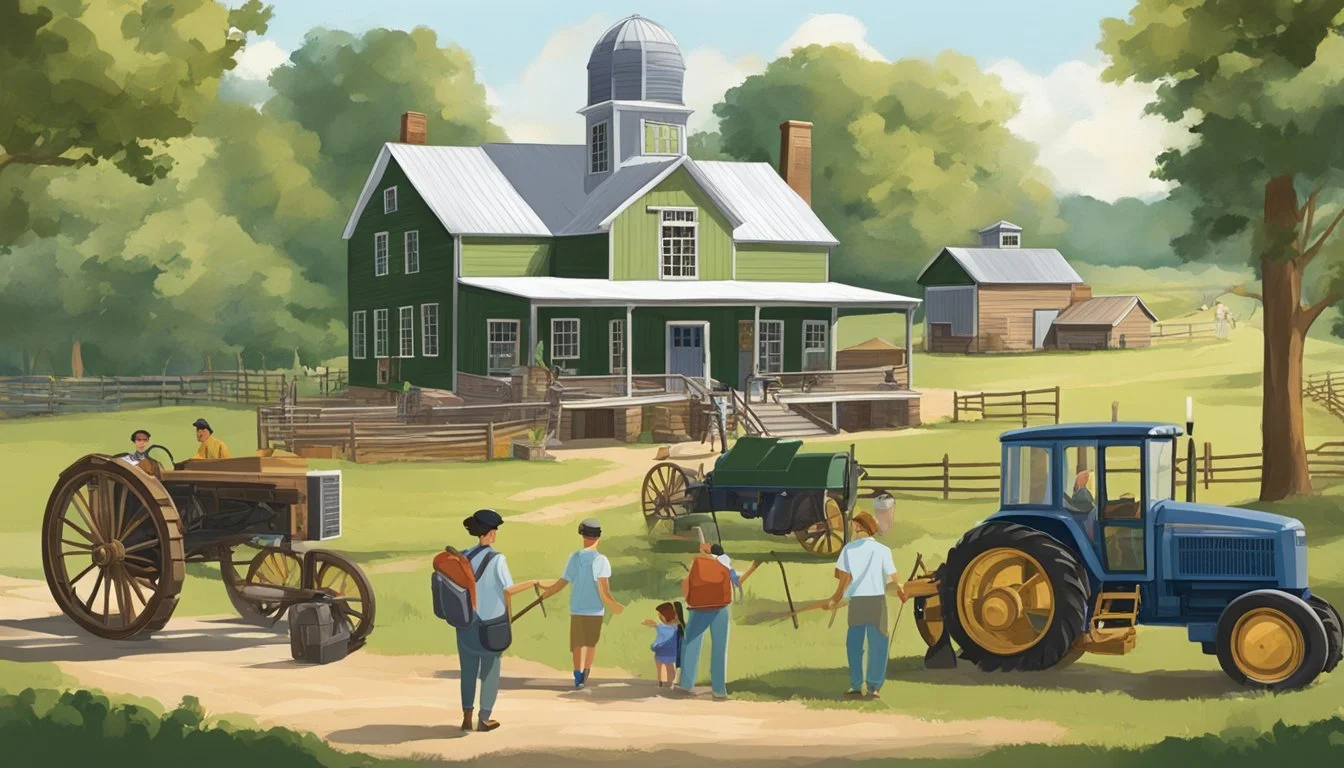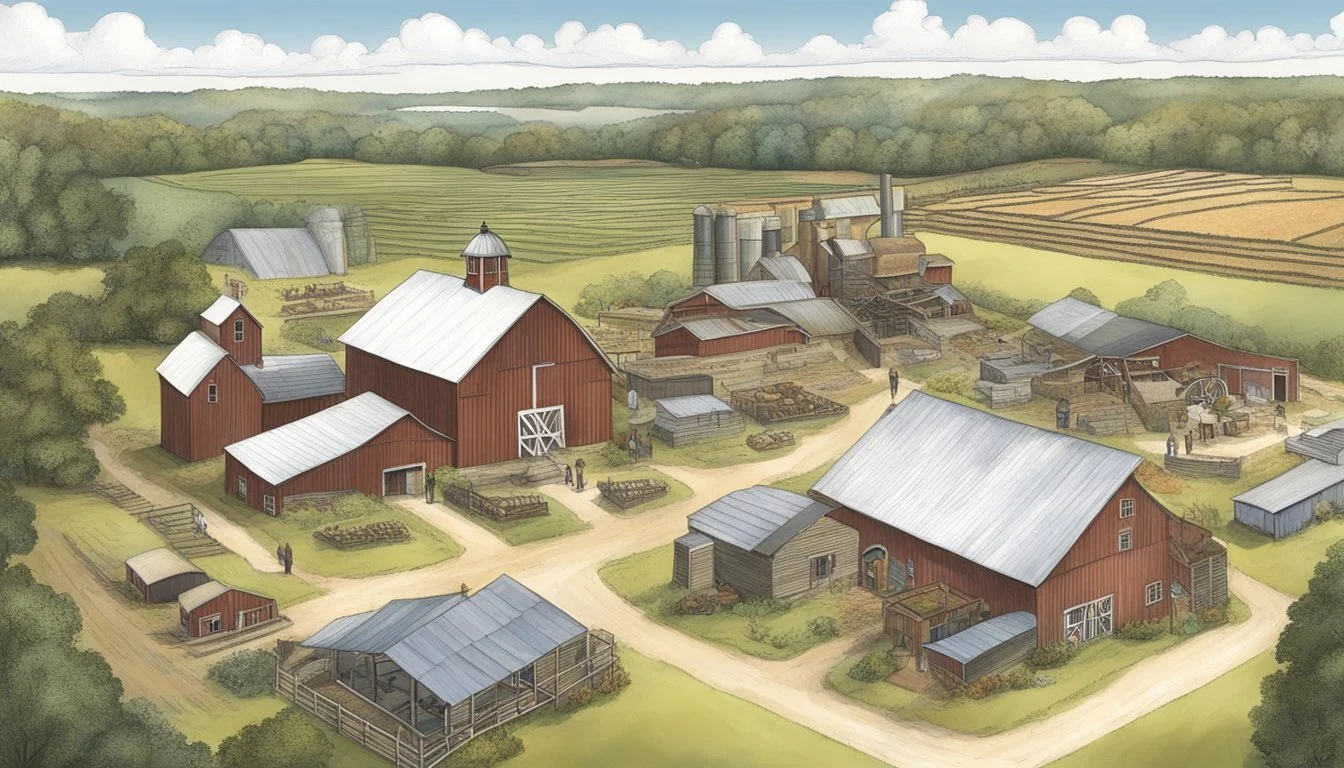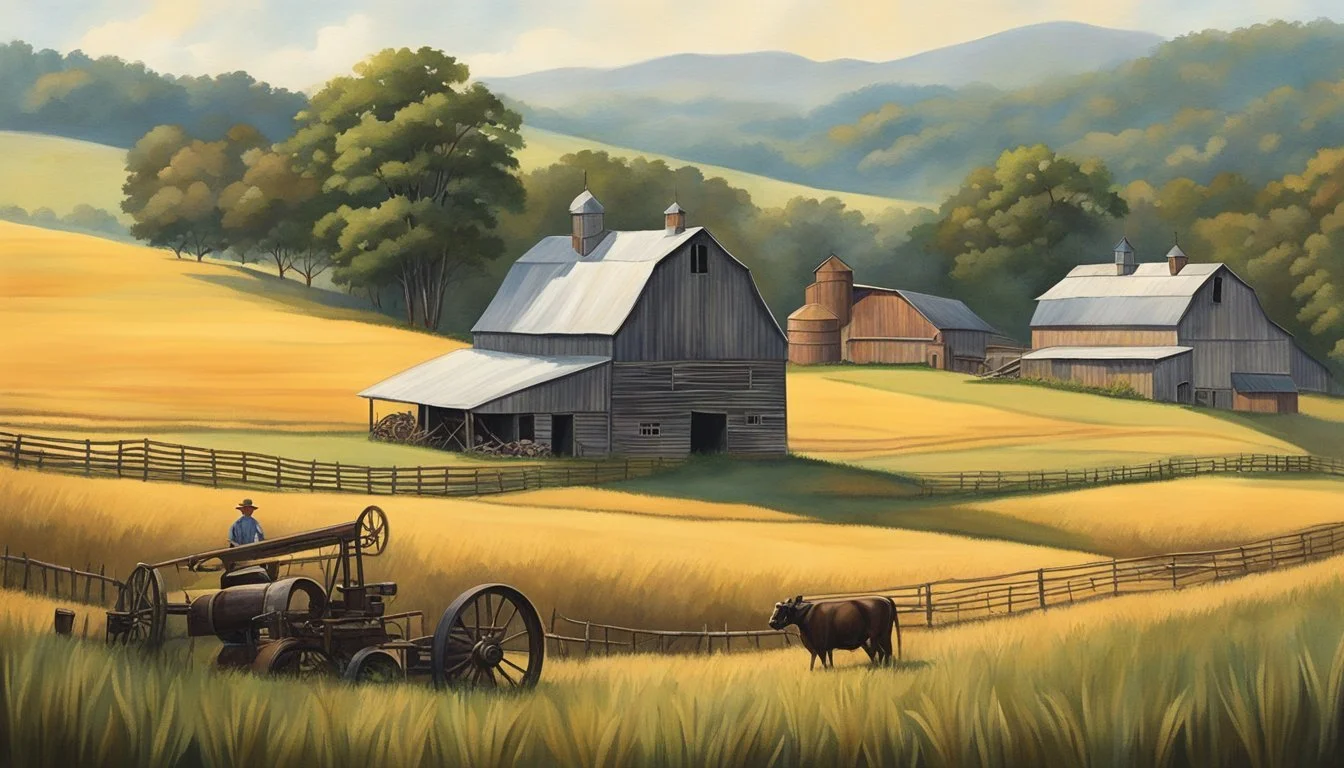Historical Farms and Agricultural Museums in North Carolina
North Carolina, with its rich agricultural history, affords visitors an insightful glance into its rural past through various historical farms and agricultural museums. These institutions preserve the legacy of farming in the region, showcasing how agriculture has shaped the local culture, economy, and landscape over the centuries. A journey through these museums offers a unique look at the implements, techniques, and lifestyle of North Carolina's agrarian ancestors.
Among these cultural treasures, the List of museums in North Carolina provides a comprehensive overview of places where one can immerse themselves in the state's agricultural heritage. Each museum plays a pivotal role in conserving and educating the public about the evolution of farming practices, tools, and the rural way of life.
Exemplifying this is the Mountain Farm Museum and Mingus Mill, assembled from historic structures across the Great Smoky Mountains National Park. It offers a hands-on understanding of farming life a century ago. The North Carolina Rural Heritage Center further expands upon this glimpse into the past by demonstrating the advancements in agricultural technology and celebrating the heritage of the indigenous tribes, illustrating how each has influenced the state's rural history.
Historical Significance of North Carolina Farms
North Carolina's agricultural history is deeply rooted in its farms, which have weathered through pivotal eras such as the Civil War, have been the birthplaces of significant agricultural innovations, and are now celebrated and preserved at various historic sites and museums.
Civil War Influence
During the Civil War, North Carolina farms were critical resources, providing sustenance for both civilian and military populations. They experienced a drastic transformation as the war effort demanded increased production, often leading to intense labor shortages due to the conscription of men. These conditions catalyzed a shift in farm labor demographics, including a greater involvement of women and children in agricultural roles.
Agricultural Advancements
Post-war periods saw North Carolina farms embrace new agricultural advancements that propelled the state into modern farming practices. Innovations such as the introduction of crop rotation and the widespread use of fertilizers led to enhanced yields and soil recovery. This period signifies an evolution from traditional methods to a more scientific approach to agriculture, including the development of farm machinery that increased efficiency.
Preservation and Recognition
Many historic North Carolina farms have been acknowledged for their cultural value and preserved as historic sites. They serve as living museums, often listed on the National Register of Historic Places, providing tangible connections to the past. These sites offer educational opportunities for visitors to understand the evolution of farming and its enduring impact on society. Through this recognition, the state honors the legacy and ongoing relevance of its agricultural heritage.
Key Historical Farms and Museums
North Carolina's agricultural heritage is vividly preserved through a selection of historical farms and museums. These institutions provide an in-depth look into the past farming practices, architectural styles, and the lifestyle of rural communities.
Mountain Farm Museum
Operated by the National Park Service, the Mountain Farm Museum is an open-air museum that showcases a collection of historic log buildings. Visitors can explore a log farmhouse, barn, apple house, springhouse, and a smokehouse to get a sense of farm life in the Appalachian Mountains.
Scotland County Farm Museum
Located in Scotland County, this farm museum captures the essence of rural life in the late 19th and early 20th centuries. Alongside a visitor center, the museum boasts a blacksmith shop and a collection of agricultural tools and machinery that reveal the ingenuity of past farming techniques.
Carolinas Indian Museum
Part of the North Carolina Rural Heritage Center, the Carolinas Indian Museum pays homage to the rich cultural heritage of Native American tribes in the region. It offers a plethora of artifacts that educate visitors on the traditions, crafts, and way of life of the indigenous peoples of the Carolinas.
John Blue House and Heritage Center
The John Blue House and Heritage Center provides a window into the history of Scotland County through the life and innovations of John Blue. The center features a variety of outbuildings including a cotton gin, and a barn, and showcases a broad collection of domestic items and farm equipment from the late 1800s to the early 1900s.
Architecture and Farming Structures
The historical farms and agricultural museums in North Carolina provide insight into the distinctive architecture and building structures integral to the region's agricultural heritage. These structures, ranging from practical barns and smokehouses to the grand plantation houses, reflect the various agricultural practices and societal norms of their time.
Tobacco and Corn Barns
In North Carolina, tobacco barns and corn cribs were essential structures on many farms. They were specifically designed for the curing of tobacco or drying and storing corn, vital crops in the state's economy. Tobacco barns, often constructed from logs or lumber, featured vented walls to control the curing process. Corn cribs were usually more open to allow air circulation preventing spoilage of the stored grain.
Plantation Houses and Slave Quarters
The architecture of plantation houses in North Carolina bears witness to the state’s complex history, showcasing both the wealth of the planters and the somber reality of slavery. These houses were typically built in the antebellum style with large porches and tall columns. In stark contrast, slave quarters were markedly utilitarian, often constructed hastily from wood, providing minimal comfort and privacy.
Cotton Gins and Smokehouses
Cotton gins, vital for processing cotton—a key driver of the state's economy—were commonly found in rural North Carolina. These buildings housed machinery that separated cotton fibers from their seeds. Smokehouses, another common feature on historical farms, were used for preserving meat through smoking, a necessity before the advent of refrigeration. They were typically simple, wood-constructed buildings, sometimes with a masonry base and a ventilation system to manage the smoke flow.
Living History and Demonstrations
Living history demonstrations in North Carolina provide an interactive glimpse into the state's agricultural past. Visitors can engage with various aspects of 19th and 20th-century farm life, from ironwork to textile production.
Blacksmithing and Cast Iron Work
At historical farms, blacksmith shops are a bustling hub where the craft of shaping iron into tools and household items comes to life. Demonstrations often feature cast iron work, creating pieces essential to daily living during the period. These exhibits allow visitors to understand the intricate work behind metalwork of the era.
Textile Production and Domestic Life
Textile production is a key feature of living history sites, showing how garments and domestic textiles were made. Through demonstrations of spinning, weaving, and stitching, visitors gain insights into the textile-making process. Domestic life is also presented in farm buildings, where guides dressed in period attire illustrate home life from cooking to craft.
Farming Techniques and Equipment
Historical farms showcase traditional farming techniques and the evolution of farming equipment. From hand-tools to horse-drawn plows, these exhibits demonstrate the labor-intensive agriculture of North Carolina’s past. Farms might also display the transition from animal power to early tractors, detailing advancements in farming technology.
Educational Programs and Visitor Experience
Educational programs and visitor experiences at North Carolina's historical farms and agricultural museums are designed to offer immersive learning opportunities. They enable visitors to engage with the state's rich rural history through hands-on activities, guided tours, and interactive exhibits.
Guided Tours and Cultural Events
Guided Tours: Visitors can explore the North Carolina Rural Heritage Center through guided tours that provide insight into the rural Carolinas in the late 1800s. The tours are led by knowledgeable guides who share anecdotes and facts about the village's collection of homesteads, barns, and general stores.
Cultural Events: Throughout the year, events such as demonstrations of traditional crafts and seasonal festivals offer a deeper understanding of the historical lifestyle.
Interactive Exhibits and Workshops
Interactive Exhibits: The Randleigh Dairy Heritage Museum features exhibits that teach visitors about the journey of milk from farm to table. The museum allows visitors to interact with the displays, enhancing their learning experience.
Workshops: Alongside exhibits, workshops provide a hands-on approach to learning about traditional farming methods. The Eastern Carolina Village and Farm Museum preserves architectural and agricultural history and often hosts workshops that allow visitors to experience farm life from 1840 to 1940.
Museums' hours of operation vary, so visitors are encouraged to check online or contact the visitor center for up-to-date information before planning their visit.
Community and Cultural Heritage
In North Carolina, community gatherings and traditional crafts are vital in preserving the area’s rich cultural heritage, from the stories of the Cherokee to the agricultural practices of Scotland County.
Annual Events and Festivals
North Carolina's calendar includes various annual events that pay homage to the state's agricultural roots and diverse cultural history. At the North Carolina Rural Heritage Center, visitors can experience agricultural technology from the late 19th century and explore the Carolinas Indian Museum, which celebrates the heritage of native tribes in the region. These events are a display of Scotland County's community pride and serve as an education on the traditional ways of life that shaped the local history.
Local Crafts and Gardening Practices
The artisanship and gardening practices within North Carolina mirror the state's history. From the intricate beadwork linked to the Cherokee people to the heritage gardens found in historic plantations, local crafts and gardening knowledge have been passed down through generations. For instance, Horne Creek Farm, a living historical farm, provides insight into historical agricultural methods and the cultivation of heritage plants.
North Carolina’s historical farms and museums not only preserve the past but also educate the community and visitors about the state’s rich cultural fabric, contributing to a shared understanding and appreciation of its heritage.
Visitor Information
This section provides specific details on admission fees, operational hours, and the amenities available at historical farms and agricultural museums across North Carolina.
Admission Fees and Membership
Mountain Farm Museum and Mingus Mill: This destination offers a journey into rural life 100 years ago with no admission fee. For more information, visitors can find details at the U.S. National Park Service website.
NC Rural Heritage Center: To explore a bygone era, a visit to this center includes both a Museum of Agricultural and History and the Carolinas Indian Museum. Details on fees for individuals and group rates can be consulted at the North Carolina Rural Heritage website.
North Carolina State Historic Sites: The array of historic sites throughout the state offers various experiences, with many not requiring an entry fee. Some sites may offer memberships for those who frequent the museums. For specific fees, visitors should check the official site.
Opening Hours and Seasonal Accessibility
Mountain Farm Museum and Mingus Mill: They welcome visitors to explore the past within the park's usual hours, typically from sunrise to sunset. Seasonal changes may affect accessibility. The park's website has the most current information.
NC Rural Heritage Center: Open Saturdays from 10 AM to 4 PM and Sundays 1 PM to 4 PM, this center may also welcome guests by appointment outside these hours. Before planning their visit, guests should confirm hours of operation at the center's contact page.
NC State Historic Sites: Each historic site has its own set of hours, potentially influenced by the season. Prospective visitors will find updated information on the official state site.
Facilities and Accessibility Features
Visitors to these sites can expect basic facilities, such as parking and restrooms. Specific amenities like gift shops may vary by location.
Mountain Farm Museum and Mingus Mill: The museum offers accessible features for a diverse range of visitors and provides information on the same through their accessibility page.
NC State Historic Sites: They aim to accommodate all visitors, with many sites offering accessible options. For the most accurate details on facilities, the NC Historic Sites webpage would be the go-to resource.
Conservation and Future Challenges
In North Carolina, the delicate interplay between maintaining historical farms and the push for modern development presents unique challenges and opportunities. This balance is especially pertinent when considering the funding necessary to support conservation and the educational mandates aimed at community engagement.
Funding and Economic Impact
The conservation of historical farms and agricultural museums in North Carolina hinges on the availability of reliable funding. Specific initiatives, such as increasing the Land and Water Fund, aim to bolster conservation efforts with proposals for incremental funding increases leading up to $45 million by FY24-25. These monetary inflows not only preserve the state's rural heritage but also stimulate economies, particularly in regions like Eastern North Carolina where agriculture remains a cornerstone of community livelihood.
Educational Outreach and Community Involvement
Educational programs spearheaded by entities like the NC Rural Heritage Center play a crucial role in nurturing awareness and fostering stewardship among local populations. Partnerships with the National Park Service amplify these efforts by embedding conservation priorities within the regional narrative. Museums serve as key platforms for engaging the community, using exhibits and events to discuss the importance of historical farms and the underpinning ecologies that support them. Educational outreach in North Carolina thus becomes a tool not only for informing but also for involving United States citizens in the preservation of their collective agricultural legacy.
Regional Farming Heritage
In North Carolina, the rich tapestry of agricultural history is preserved and celebrated through various historical farms and agricultural museums. They provide insight into the diverse farming practices and rural life prevalent across the state from the mountainous regions to the coastal plains.
Eastern North Carolina Traditions
In the flat, fertile plains of Eastern North Carolina, traditional farming techniques have deep roots. The North Carolina Rural Heritage Center highlights these traditions, showcasing how agriculture shaped the region's culture and economy. Visitors can see firsthand the evolution of agricultural technology and how it influenced rural life in this area.
Mountain Area Agricultural Practices
The Appalachian Mountains provide a unique backdrop for mountain farming traditions. The Mountain Farm Museum, a collection of historical log buildings, offers a glimpse into the self-sustaining lifestyle of early mountain farmers. Here, one will find the ingenuity required to farm the challenging terrain and the resourcefulness of the mountain people.
New Bern Historical Society
Located in the atmospheric town of New Bern, the New Bern Historical Society is a custodian of the agricultural past. It emphasizes the historical importance of farm life within the town’s development and the broader Eastern North Carolina region. The society's efforts ensure that the stories and practices of the past continue to enlighten the residents and visitors of New Bern.
Maps and Guides
Navigating North Carolina's heritage farms and agricultural museums is made easier with an array of maps and guides designed for visitors. These tools are invaluable for enhancing the understanding and appreciation of the rich historical context these institutions offer.
Virtual Tours and Online Resources
Many museums have adapted to the digital age by offering virtual tours and online resources. For instance, the North Carolina Rural Heritage Center provides digital insights into both the Museum of Agricultural and History and the Carolinas Indian Museum. Visitors can explore exhibits and learn about rural life and agricultural advancements through the centuries, all from the comfort of their home.
Printed Maps and Brochures
When it comes to a physical visit, printed maps and brochures serve as essential tools. Comprehensive guides are often available at visitor centers, detailing historical significance and pinpointing various exhibits within the museums. The U.S. National Park Service offers a self-guiding tour booklet at the Mountain Farm Museum, enriched with historical photographs and illustrations that flesh out the narrative of farm life from a century ago. These printed materials help structure the visitor’s experience, ensuring no significant aspect of the museums is overlooked.
Conclusion
North Carolina's rich agricultural past is preserved through various museums and historic sites across the state. These institutions offer a window into the early farm life, showcasing the evolution of farming practices and technology. The North Carolina Rural Heritage Center serves as a cornerstone for understanding this evolution, with exhibits that highlight agricultural technology and rural life spanning from the 19th century to modern times.
The Museum of Agricultural and History provides vivid glimpses into the lives of farmers, emphasizing inventions that simplified rural living throughout the years. Visitors gain insights into the heritage and culture of the diverse peoples, including Native American tribes, who have influenced North Carolina's agricultural landscape.
NCpedia provides a valuable digital resource detailing the History of Farming in North Carolina, tracing back to changes in agriculture during the 1800s. Soil depletion from crops like cotton, leading to farm abandonment, is one of the notable shifts covered in this context.
Additionally, the contributions of small farmers, who helped revive farm ownership between 1880 and 1920, are acknowledged, with southeastern North Carolina being home to over 15,220 small farm owners at one point. Such rich history underscores the broader narrative of farming's impact on North Carolina's social and economic development.
Through these repositories of history, North Carolina honors the legacy of its agricultural foundations. They are not only a tribute to the past, but also educational platforms that inform present and future generations about the deep-rooted connections between land, people, and cultivation that have shaped the state.










